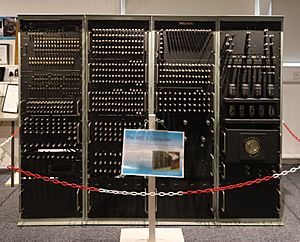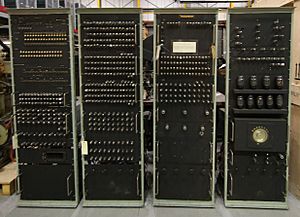Hollerith Electronic Computer facts for kids
The Hollerith Electronic Computer (HEC) was an early computer made by the British Tabulating Machine Company (BTM). It was designed by Professor Andrew Booth from Birkbeck College in London. The HEC was special because it was the first business computer made in large numbers in Britain. The very first version started working in late 1951.

Hollerith Electronic Computer 1 at the National Museum of Computing
|
|
| Developer | Andrew Booth |
|---|---|
| Manufacturer | British Tabulating Machine Company (BTM) |
| Release date | 1951 |
| Dimensions | 1.5 m high by 3m wide by 0.5m deep |
Contents
How the HEC Computer Started
In 1950, a scientist named John Womersley joined a company called BTM. He had worked on another early computer before this. John Womersley saw that businesses needed smaller, cheaper computers.
So, he asked Andrew Booth to help design one. Andrew Booth was a professor at Birkbeck College. He had already been working on his own computer design.
Booth needed special machines to read and punch data cards. BTM agreed to give him these machines. In return, BTM could copy his computer design, including its special memory system.
In March 1951, a team from BTM went to Booth's home. They found him building his first computer in an old barn.
Building the HEC Computer
Dr. Bird and his team from BTM built their own copy of Booth's machine. They called it HEC 1. It was built at their factory in Letchworth.
The HEC 1 was quite large, about 1.5 meters tall, 3 meters wide, and 0.5 meters deep. It used simple electronic parts. It had about 1,000 old vacuum tubes, which are like tiny light bulbs that control electricity.
The computer's memory was a spinning drum. This drum was about 5.5 inches (140 mm) across. It could store 2 kilobytes of information. That's much less than a single picture on your phone today!
The HEC 1 could do complex math, like multiplying large numbers. It took about 640 milliseconds to multiply two 32-bit numbers.
Later Versions of HEC Computers
Over time, the HEC design got better. They made drums that could store more information.
In 1953, a newer version called HEC 2 was shown at an exhibition in London. Then, in 1955, the first production model, HEC 2M, was ready.
About seven or eight HEC 2M computers were sold to different companies. These included GE Research, Esso, and the Royal Aircraft Establishment. Some were even used for testing airplanes in wind tunnels.
The next big step was the HEC 4. This machine was designed specifically for business tasks. In 1959, BTM merged with another company. The HEC 4 then became known as the ICT 1201. About 100 of these machines were sold.
Where is the HEC 1 Now?
The very first HEC 1 computer was kept in a company museum for a while. In 1972, it was moved to the collection of Birmingham museums.
It was on display for some time. By 2002, it was in the Birmingham Museum Collection Centre. There was a plan to lend it to Birkbeck College, but that didn't happen.
In 2014, The National Museum of Computing asked to borrow the computer. It was moved there on October 12, 2015. After being cleaned up, it was officially shown to the public in April 2016. Dr. Bird, who helped build it, was there for the event.



